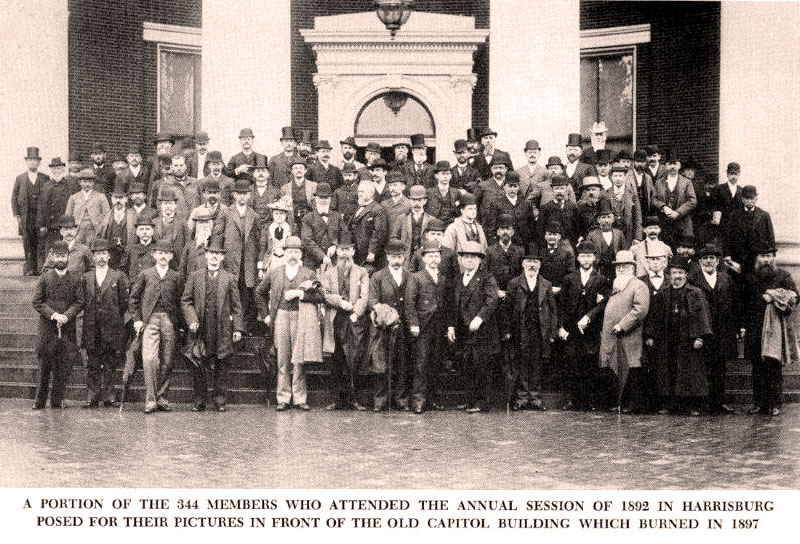Last Updated: Dec 7, 2022

Prior to 1848, the commonwealth of Pennsylvania had just a handful of district and county medical societies, and there was little to no communication or collaboration between the groups. Realizing the need for a more organized, statewide system, Wilmer Worthington, MD, of Chester County prepared the following resolution at a meeting in December 1847:
“Whereas, No state medical society exists in Pennsylvania; and believing that such an institution would greatly contribute to the advancement of medical knowledge within its bounds; therefore,
Resolved, That it is expedient to hold a convention at such time and place as may be hereafter agreed upon…
Resolved, That the corresponding secretary be directed to forward a copy of these proceedings to the different medical schools and associations in the Commonwealth, and solicit their early cooperation.”
Spurred by this resolution, Lancaster County offered their own declaration soon after:
“Resolved, That this society now proceed to the election of delegates to a state medical convention, for the purpose of forming a state medical society, at such time and place as may be hereafter agreed upon.”
In early 1848, physicians in Chester and Lancaster counties extended an invitation to their colleagues in county medical societies and medical schools across Pennsylvania to attend a “convention of medical men.” The meeting was held on April 11th at the First Methodist Episcopal Church in Lancaster, and a total of 61 people gathered, representing the counties, the University of Pennsylvania, the Jefferson Medical College, the Pennsylvania Medical College, and the Philadelphia Association for Medical Instruction. This meeting set in motion the initial plans to establish a state medical society, with the group electing their first president, Samuel Humes, MD, and voting for each attendee to pay $1 to help offset the costs of publishing the meeting’s notes.
The second meeting was held one year later, in April 1849, this time with only 31 physicians in attendance. The group looked to the model of the newly founded American Medical Association, reflecting on its objective to “promote the science and art of medicine and the betterment of public health,” as they crafted their own goals and initiatives.
Dr. Humes and the group addressed an extensive agenda, with topics ranging from ethical and legislative issues to a smallpox outbreak in Lycoming County. The meeting ended with passing a resolution to seek vital statistics legislation that would register births, marriages, and deaths, as well as a plan to pursue universal vaccination.
Early meeting records illustrate physicians' concerns with the ethics of their profession, as well as worries over safeguarding medical education and professional qualifications. It was also evident that the society faced an urgent need for physician activism and leadership as it grappled with a variety of public health issues, including topics such as, “Does dysentery prevail most in sections where iron is infused in the soil?” and “Does clearing off of timber tend to increase affections of the nerves and intestines?”
As time went on and the Society solidified its presence, the group celebrated many accomplishments during its first century, including the passage of a bill for statewide registration of vital statistics, the creation of the Pennsylvania Department of Health, and the establishment of a state commissioner of public health.
The 100th year anniversary marked new innovations and discoveries for the Society, accompanied by a medical profession that was thriving nationally. During the 1950’s, the Society initiated a “Safeguard Your Health” program, which aimed to share more information about public health with a wider audience. Through the use of newspaper columns, pamphlets, academic conferences, press releases, radio service messages and extensive scientific session coverage, the Pennsylvania Medical Society was known throughout the state for being the first and best source for public health-related education.
A 1955 radio show script notes, “Yes, medicine has made much progress in the past 40 years…. so much so that some doctors feel that medicine before this period can be considered as medicine practiced in the Dark Ages. With the discovery of sulfa, penicillin, streptomycin, and other new drugs in the past few years, we are able to cure many diseases today - diseases that took the lives of many people before the discovery of these new drugs.”
And while the Society remained a leader in medical initiatives, the second half of the 20th century brought with it sweeping changes and adjustments as the world continued to quickly progress. The role of being a public health informer began to fall more to the private and public agencies who held the resources necessary for the expansive education needed.
After dealing with unprecedented challenges including the introduction of Medicare, the evolution of complex hospital systems, HMOs, and the malpractice insurance crisis, the Society decided to shift its focus, opting to utilize its professional strength to protect and promote the well-being of physicians across the state.
Today, 175 years after that first meeting in Lancaster, the Pennsylvania Medical Society continues its original purpose of fostering the advancement of medical knowledge, relieving suffering, and promoting the health of the community. The mission remains the same as William S. Foster, MD, shared during his 1896 address to the State Society Delegates: “....it then follows that the ordinary physician who willingly, earnestly, and actively fulfills the ordinary demands of citizenship becomes the state’s most valuable citizen…. A doctor ought to take an interest in politics - local, state, and national…. There is much for this Society to do for the state, and in doing for the state to advance at once its own honor and the welfare of every citizen however humble.”